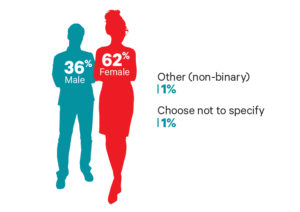Do we have your attention?
Good.
Let’s delve into an analysis of genders in the optical industry.
We took the data provided by respondents to this year’s Big Survey and created a profile of a top earner in the optical profession. We had to trim the profile for length in print. So here it is in its entirety:
Top Earner Profile
There is no one way to be financially successful in eyecare, but a statistical picture of those ECPs earning the most (more than $250K) would look something like this:
He (yes, 85% are male) operates a single-location private practice with a strong focus on retail in the suburbs of a major urban market (odds are it’s a free-standing building or in a strip mall in the Southwest or West). He’s learned a thing or two over the years — 69% of the top earners are over 50. He works hard (averaging 45 hours a week) but also knows when to rest, with 61% getting the recommended seven hours or more of sleep a night. He runs a tight optical, too: nearly 60% of our most successful ECPs claim their sales team has a conversion rate of over 50%, with designer licensed ophthalmics doing the heavy lifting.
Advertisement
After finishing that analysis, we wondered what a profile of the lowest earners in the optical profession would look like. We went back to the data and came up with this:
Subhead: Lowest Earner Profile
A statistical picture of those earning the least (less than $30K) would look something like this:
She (yes, 67% are female) operates a single-location private practice with a strong focus on retail out of a free-standing building or downtown storefront, most likely in the Southeast or Northeast. The bulk of these respondents are located either in the suburbs of a major urban market (about one-third) or in a medium-sized city or college town (another third). Some 67% of this group are over 50. They work longer than their top-earning peers, averaging nearly 50 hours a week, and sleep less—half of them get six hours or fewer of sleep a night—which doubtless helps explain why a full 61% feel they are not fairly compensated for the work they do. Roughly half of these businesses claim a sales conversion rate of over 50%, with designer licensed suns being their best performers.
Analyzing the Results
What do these numbers tell us?
Both profiles paint a picture of a hard worker over the age of 50. However, the lowest earners seem to be putting in more hours per week – 50 vs. 45 – and getting less sleep per night – 6 hours or less vs. 7 hours or more – than their highest-earning counterparts.
And then there’s the unmistakable gender disparity: The respondents who identify as earning more than $250K/year were overwhelmingly male, at 87%. Those who make less than $30K/year were a majority women, at 67%.
That’s a massive gap.
Advertisement
With piqued curiosity, we went back to the data a third time for a He vs. She comparison. The results there, however, were more level. For example, using gender as the only filter, there was very little difference in the responses to the question Do you feel fairly compensated?
We delved ahead.
 The majority of our respondents are women – about two out of every three. But the majority of our male responders are owners. And in this data set, males skew older than females.
The majority of our respondents are women – about two out of every three. But the majority of our male responders are owners. And in this data set, males skew older than females.
That seems to be where the main discrepancies lay between the highest and lowest earners in the field.
The men who responded to The Big Survey are older, so they’ve had more time to establish themselves. They also were more likely to be owners, so profits go to them.
Conclusion
Cheeky headline aside, men, as a group, are not better earners in the optical industry. They’ve just had a head start.
Advertisement
Women owners and O.D.s turn a profit just as well as their male counterparts. There just aren’t as many of them in the field.
Yet.
Thanks to society’s renewed focus on equity and diversity, many of the economic barriers and stereotypes of past generations may wear away. As they do, we expect the gender gaps showing up in our data will decrease.
Until then, we offer a toast to the highest earners and lowest earners alike: May you keep building on your successes as you forge your careers in the field.